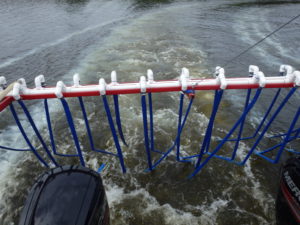PVIA has completed its third application of alum to the waters of Quarry Island Cove at Lake Wister, on July 27 and 28, 2017. Alum (aluminum sulfate) is used every day in the water treatment plant to help remove particles from the water.  Its use in lakes is new in Oklahoma–PVIA’s application in August 2014 was the first in the state. Applying alum has both short-term and long-term benefits. In the short term, it clears the water column–similar to its role in the water treatment plant. Applying it in late July or early August means the clearing process helps to reduce the amount of cyanobacteria (aka blue-green algae) in the water, at the time of year it is typically most abundant. Long-term, the alum settles on the bottom of the lake and becomes incorporated into lake sediments. There it forms a chemical barrier that intercepts and immobilizes phosphorus as it is released from lake sediments. By binding this phosphorus, the alum keeps it from being available to fertilize and grow more algae. After each alum application, sediment cores are taken from the lake and analyzed. These tests show that so far over half the phosphorus in the lake sediments in Quarry Island Cove has been permanently immobilized. Based on the results seen in the cove, PVIA hopes that funding may someday be found to apply alum to all of Lake Wister.
Its use in lakes is new in Oklahoma–PVIA’s application in August 2014 was the first in the state. Applying alum has both short-term and long-term benefits. In the short term, it clears the water column–similar to its role in the water treatment plant. Applying it in late July or early August means the clearing process helps to reduce the amount of cyanobacteria (aka blue-green algae) in the water, at the time of year it is typically most abundant. Long-term, the alum settles on the bottom of the lake and becomes incorporated into lake sediments. There it forms a chemical barrier that intercepts and immobilizes phosphorus as it is released from lake sediments. By binding this phosphorus, the alum keeps it from being available to fertilize and grow more algae. After each alum application, sediment cores are taken from the lake and analyzed. These tests show that so far over half the phosphorus in the lake sediments in Quarry Island Cove has been permanently immobilized. Based on the results seen in the cove, PVIA hopes that funding may someday be found to apply alum to all of Lake Wister.
Alum III
Next post: Lake Wister Water Quality Modeling & TMDL Report
Previous post: Dr. Ken Hammond
